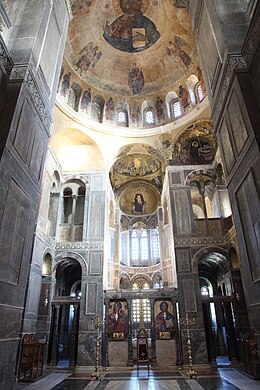Hosios Loukas
Hosios Loukas (Greek: Ὅσιος Λουκᾶς) is a historic walled monastery situated near the town of Distomo, in Boeotia, Greece.
The monastery derived its wealth (including funds required for construction) from the fact that the relics of St. Luke were said to have exuded myron, a sort of perfumed oil which produced healing miracles.
The saint Nicholas the Pilgrim, a local shepherd, lived for some time in the second half of the eleventh century in the monastery until he was expelled due to his abnormal behaviour.
However, the complex is not complete: the original image of Christ Pantocrator inside the dome is missing, as are the figures of archangels normally placed between the upper windows.
Apart from revetment, carving, gold and silver plate, murals, and mosaics (especially imposing on curving surfaces), the interior featured a choice assortment of icons, chandeliers, silk curtains, and altar cloths.
[7] The crypt’s frescoes were until recently covered in hundreds of years of dust and hidden but in the 1960s the crypt underwent a cleaning by the Greek Archaeological Service which revealed their remarkably well preserved state with the exceptions of the apse which has lost most of its plaster exposing brick and stone, as well as the entrance vault and groin vaults which have suffered slight damage from water seepage and minor vandalism, mostly on the lower lunettes near the entrance.
[7] The crypt contains frescoes on the entryway and its vault, eight lunettes around the walls with depictions of Christ’s Passion and Resurrection, and forty medallion portraits of apostles, martyrs and holy men, abbots including Philotheos, as well as numerous inscriptions.
[7] When Hosios Loukas was frequented by pilgrims or members of Saint Luke’s healing cult, visitors would sleep not only in the Katholikon, but in the crypt itself where the tomb was kept along with two others, believed to be abbots.






